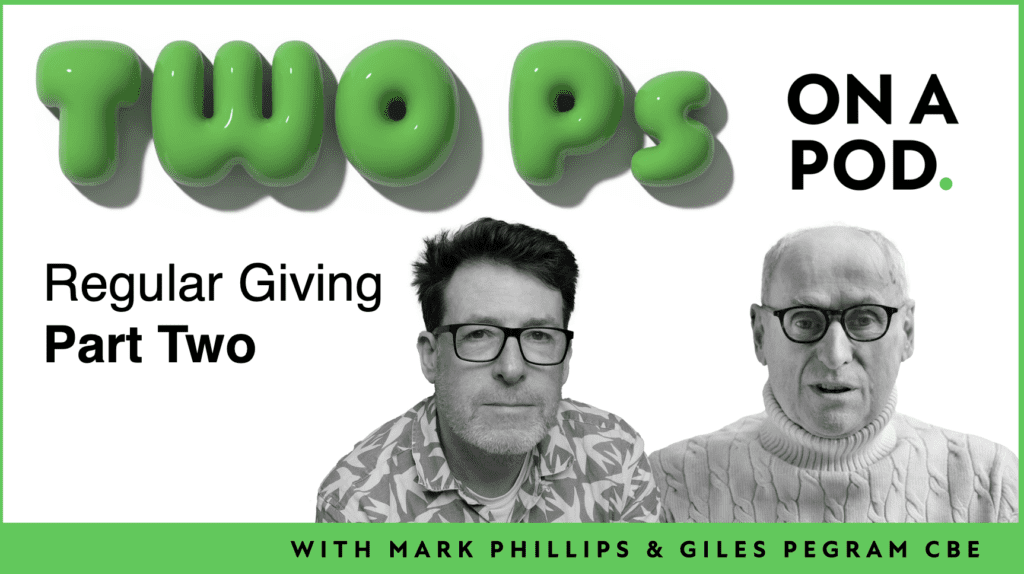Adrian Sargeant's foreword to Bluefrog's research into the causes of lapsing – donors have a right to feel good about giving
Last summer, Bluefrog presented its findings on a huge qualitative study to identify the key reasons why donors decide to stop giving.
As many of you who attended the event told me, the information was great, but the presentation wasn't.
That's why we have taken a little time to make sure we don't repeat the same mistake with the published document. Over the next few days, the final draft will be triple checked before it is published free of charge to the sector.
Luckily, we have had the opportunity to have Professor Adrian Sargeant review our work before publication. And he has very kindly written a foreword to accompany the final paper.
Often forewords can be skipped as people flick straight to the conclusions (that's what I tend to do anyway).
But I think that what Professor Sargeant has to say is of such importance that it deserves separate consideration and have reproduced it here in its entirety.
The paper will be available for download via this blog and at the Bluefrog main site on Friday. Should you want to get an advance copy, we will be launching the paper via Twitter. Please follow me here if you'd like to be at the front of the queue.
———————————————————————————–
Building donor loyalty is the single biggest challenge facing the sector today.
Finding new donors is generally a tough enough occupation, but in times of recession it is tougher still. The size of the donor pool is contracting and individuals are less than keen to take on new demands on their income. This is not a good time to be losing supporters. If changing patterns of giving in the US are reflected here (in the UK) we can expect to see the donor pool contract by around 2% this year and individual giving by circa 3%.
These figures don’t make for happy reading particularly at a time when many nonprofits are facing increased demand for their services. Given all this, we would expect the sector to focus on easy fixes to improve their financial position. This is sadly not the case. We continue to waste large sums of money on unnecessary acquisition and neglect that fact that were we to achieve even minute increases in donor retention the impact on performance would be profound.
Picking an easy number to illustrate, I estimated back in 2004 that a 10% increase in retention could lead to a whopping 200% increase in the lifetime value of the fundraising donorbase. Putting aside the savings in acquisition, if donors hang around for longer they do sexy things such as upgrading their giving, giving in multiple ways, buying from the trading catalogue, recommending the organisation to others and ultimately perhaps, pledging a legacy gift to the organisation.
The single biggest indicator of whether a legacy will happen (demographics aside) is the longevity of the preceding donor relationship. People who give for extended periods of time are significantly more likely to remember a charity in their will.
Sometimes at sector conferences I’ve been challenged by fundraisers on these numbers. After all, the increases do seem rather on the large side. Well here’s the rub. Smart fundraisers need to calculate for themselves what difference a 1%, a 2% or a 5% improvement in loyalty would make to their organisation. Really smart fundraisers then ensure that everyone in a donor or customer facing role understands these figures, so that the next time they’re in a position to assist a donor, provide additional information, or to ensure that the communications choices they specify are met, that they do their bit to make these figures a reality.
Putting aside practical issues such a shortage of cash, previous quantitative research has shown that there are actually three key drivers of loyalty.
- Donor satisfaction with the quality of service provided by the nonprofit.
- How committed a donor feels to the organisation (its mission and values).
- The extent to which the organisation is trusted by its donors to spend its money wisely and act in a manner consistent with its values and deliver on its promises.
There are thus a wealth of actions that a charity can take to build loyalty by focusing on these issues. In the current report the team from Bluefrog build on this knowledge by exploring how donors feel about their relationships with the organisations they support. They paint a rich qualitative picture of why individuals stop giving, how they feel about terminating their support and the role that the charity and its fundraising team may have played in precipitating this action.
The paper offers a number of fascinating insights and crucially, innumerable practical steps that organisations can take to build loyalty. It is therefore a must read for anyone serious about donor retention, improving the performance of their fundraising and most significantly of all, enhancing the quality of the giving experience for their supporters.
Donors have the right to feel good about their giving and we should be doing everything we can to facilitate that goal.
Adrian Sargeant
Adrian Sargeant is the Robert F. Hartsook Professor of Fundraising at Indiana University – Purdue University, Indianapolis. He is also Professor of Nonprofit Marketing and Fundraising at Bristol Business School in the U.K. and Adjunct Professor of Philanthropy at the Centre for Philanthropy and Nonprofit Studies, Queensland University of Technology, Brisbane, Australia. He is also the managing editor of the International Journal of Nonprofit and Voluntary Sector Marketing.
Tags In
The Essentials

Crack the Code to Regular Giving: Insights, Strategies, and a Special Giveaway!

‘Tis Halloween. Keep to the light and beware the Four Fundraisers of the Apocalypse!

Why do people give? The Donor Participation Project with Louis Diez.

A guide to fundraising on the back of a postcard

What does the latest research tell us about the state of fundraising?





